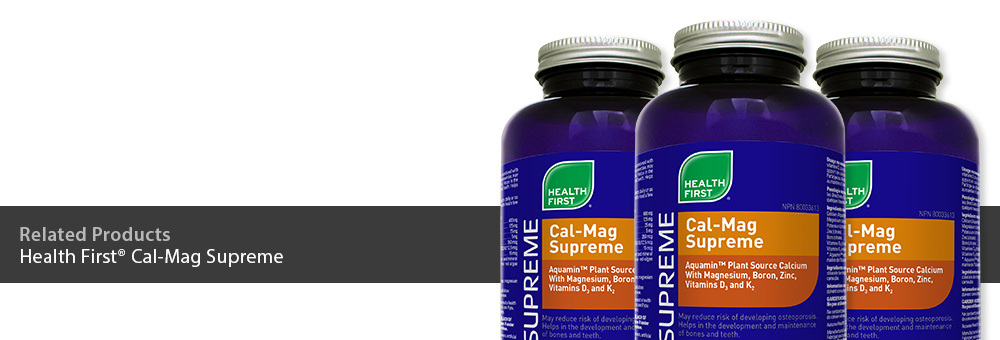

Bone building with plant-source calcium!
Osteoporosis is an all-too-common disease where decreased bone density leads to an increased risk of breakage. Bone fractures from osteoporosis most frequently affect the wrist, spine and hip, injuries which can lead to disfigurement, reduced mobility and loss of independence. Bone density peaks before the age of twenty and starts to decline after thirty. Women can lose a shocking 2-5% bone density per year during menopause.1
How common is osteoporosis in Canada? Currently over 2 million Canadians are afflicted, particularly those over fifty. Twenty-five percent of women and twelve percent of men over fifty suffer from osteoporosis. The related suffering is immense: 40% of women will experience an osteoporotic fracture after reaching fifty. Almost one quarter of those unfortunate enough to experience an osteoporotic hip fracture do not survive the first year.1
Despite a high degree of public awareness in Canada, osteoporosis frequently goes undiagnosed. Many sufferers experience no symptoms as their bone density diminishes and over one-third of those who do experience a bone fracture are never even checked (or treated) for bone density issues.1
Slowing osteoporosis
Building strong bones during childhood and teen years is the best defense to preventing osteoporosis. Once you are past this period of life, what is the optimal way to increase bone density to reduce the risk of osteoporosis? Exercise and a healthy diet are two of the most recommended actions.1
Diet-wise, the mineral calcium is one of the most well-known supplementary methods for slowing bone loss. During menopause, when insufficient calcium is available in the blood, it is pulled from the bones, decreasing bone density. PTH (parathyroid hormone) is the hormone involved in the leeching of bone calcium. Low estrogen makes the depletion worse. Because of this calcium depletion in the bones, many doctors advise women over fifty to ensure an intake of 1,200 mg of calcium per day between dietary sources and supplementation.
Concerns over calcium
One of the downsides of calcium intake at high doses is the potential risk for heart health. If the calcium is not effectively taken up by the bones, there is the risk of it building up in the arteries as plaque. This build-up can cause a narrowing of the arteries known as atherosclerosis, which can slow blood flow to the heart, leading to angina (chest pain) or even worse, increase the chances of a heart attack when undiscovered or untreated over a long period of time.
Recently the media has trumpeted such headlines as “Calcium pills taken by hundreds of thousands of women ‘double risk of heart attack and could do more harm than good” (Daily Mail, May 2012), leading calcium users to question their supplementation of this mineral.2 A large study done by the University of Auckland, looking at calcium supplement users in Germany was behind the headlines and concluded that calcium supplements at high doses may indeed be linked to an increased incidence of heart attacks. The study was quite controversial and some felt that more studies need to be done before such conclusions are drawn. The authors of the study concluded that calcium-only supplements in insolation were not as well utilized by the body as calcium from food sources.3
This brings up a key question. What if one could supplement with food source calcium, complete with all the other nutrients present in food as nature intended? Would it be safe and effective?
A plant-source calcium?
Most calcium supplements on the market are derived from mined limestone. The supplements used in the studies that have raised concerns about calcium were also sourced from limestone. As we don’t often sit down for a hearty meal of rocks, supplementing with a more “food-like” source makes sense. The algae Lithothamnion calcareum is such a source – a living, edible plant rich in calcium and other nutrients. Branded as Aquamin™, it is a red algae that grows off the coast of Iceland that naturally contains over 30% in elemental calcium. The majority of limestone-derived calcium supplements are just that – calcium. Aquamin™, being a food, contains a full complement of minerals such as magnesium, potassium, phosphorus and the trace minerals boron, strontium, vanadium, copper, silica, selenium and zinc, all of which are involved in bone health.
Originally used in Ireland as a natural fertilizer, its tremendous effects on livestock health led Lithothamnion calcareum to be investigated for human health applications. Initial anecdotal reports on the algae’s benefits for arthritic conditions led to more in-depth studies. Many clinical studies later, Aquamin™, the branded version of Lithothamnion calcareum was born.
Aquamin™ is sustainably harvested under a controlled 30-year license by the Icelandic government. Independent monitoring and continuous research is done to ensure harvest activities are not impacting the ecosystem. Only the fully calcified algae are harvested, leaving young algae to grow to full maturity. The area of harvesting is strictly controlled to ensure the material will be sustainable and harvesting is monitored by GPS systems and divers.
Aquamin™ has several clinical studies, showing safety, absorbability and effectiveness for bone health:
- Aquamin™ has been shown to reduce levels of PTH (parathyroid hormone) in the body more effectively than other forms of calcium. PTH reduces calcium content in the bones by making it available to the rest of the body. High levels of PTH are associated calcium leeching from the bones and reduced levels of bone mineral density, which can lead to osteoporosis. Aquamin™ has shown this positive effect in pre-menopausal and post-menopausal women and athletes in non-impact sports (i.e. cycling) who exhibit lower-than-normal bone mineral density.4,5,6
Measuring the absorption of various forms of calcium is difficult. Absorption can vary by the source of calcium,the delivery form, the individual human subject and meal consumption. The reduction of PTH levels in humans is so linked to calcium levels, that Aquamin™’s greater ability to reduce PTH is the conclusive proof of its superior bioavailability.5 It is believed that the porous nature of Aquamin™ is key to its superior absorption vs. other forms of calcium.
- In studies of bone cells, Aquamin™ has been shown to effectively remineralize the cells. By remineralizing the cells, the number of osteoblasts is increased. Osteoblasts are responsible for new bone formation. Researchers theorized that the synergistic effect of the mineral complex in Aquamin™ was responsible for the increase in osteogenesis (bone formation activity). 7
- Aquamin™ has been shown to have anti-inflammatory properties that help to reduce joint pain and stiffness. In fact, one clinical study showed Aquamin™ to be as effective at reducing joint pain as glucosamine sulfate and better at reducing joint stiffness! 8,9
That the Aquamin™ calcium comes from a “whole food” source with a variety of synergistic minerals and is easily absorbed by the body may account for its clinical effectiveness in bone health. Whatever the reason for its effectiveness, the human studies behind Aquamin™ should make it clear that it’s time to rethink the way you supplement your calcium.
References:
1. Osteoporosis Canada. www.osteoporosis.ca
2. Hope, Jenny. Calcium pills taken by hundreds of thousands of women ‘double risk of heart attack and could do more harm than good’. May 22, 2012, Daily Mail. http://www.dailymail.co.uk/news/article-2149031/Calcium-booster-pills-raiserisk-heart-attack-harmgood.html#ixzz21nlFlR5S
3. M. J. Bolland, A. Grey, A. Avenell, G. D. Gamble, I. R. Reid. Calcium supplements with or without vitamin D and risk of cardiovascular events: reanalysis of the Women’s Health Initiative limited access dataset and meta-analysis. BMJ, 2011; 342 (apr19 1): d2040 DOI
4. A double-blind placebo-controlled parallel group study in post-menopausal women to assess the effect of calcium supplementation on markers of bone resorption. Shandon Clinic, Cork, Ireland.
5. Frestedt JL, Kuskowski MA, Zenk JL. A single dose pharmacokinetic and pharmacodynamics comparison of two calcium supplements in pre-menopausal women. Minnesota Applied Research Centre, Minnesota, USA
6. Barry, D. W., K. C. Hansen, R. E. Van Pelt, M. Witten, P. Wolfe, and W. M. Korht. Acute Calcium Ingestion Attenuates. Exercise-Induced Disruption of Calcium Homeostasis. Med. Sci. Sports Exerc., Vol. 43, No. 4, pp. 617–623, 2011.
7. O’Gorman DM, Tierney CM, Brennan O., O’Brien 2,3 and FJ. The Marine derived, Multi mineral formula, Aquamin, Enhances Mineralisation of Osteoblast Cells In Vitro. Phytotherapy Research 2011.
8. Frestedt JL, Kuskowski MA, Zenk JL. A natural seaweed derived mineral supplement (Aquamin F) for knee osteoarthritis: a randomized, placebo controlled pilot study. Nutrition Journal 2009;8:7.
9. Frestedt JL, Kuskowski MA, Zenk JL. A natural seaweed derived mineral supplement (Aquamin F) for knee osteoarthritis: A randomised, placebo controlled pilot study MARC (Minnesota Applied Research Centre), Minnesota, USA. Published: Nutrition Journal 2009, 8:7

